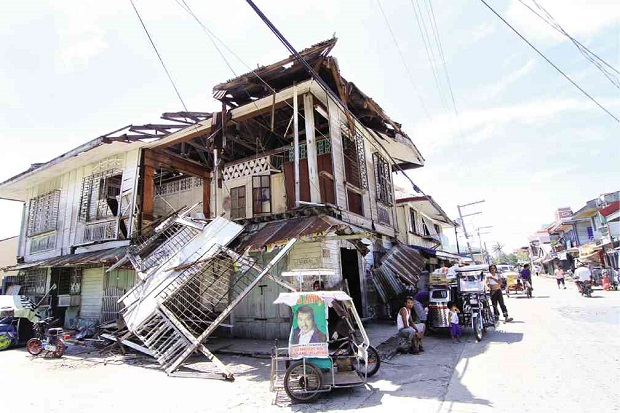
THE SPANISH-ERA house of Francisco de Jesus Sr. damaged by strong winds brought by Typhoon “Glenda” to Unisan town, Quezon province. DELFIN T. MALLARI JR./INQUIRER SOUTHERN LUZON
UNISAN, Quezon—The old wooden sections and rusty window grills of popular heritage houses in this town had survived wars and the natural elements.
Not Typhoon “Glenda” that struck the province from Tuesday night to Wednesday morning with winds of up to 150 kilometers per hour.
Mayor Nonato Puache told the Inquirer that town officials have counted at least 20 houses damaged by Glenda.
Puache said the town, which residents claim is the oldest municipality in the country having been established in 1521, the same year Ferdinand Magellan landed on the Philippines, had more than 30 heritage houses, all built during the Spanish colonial period.
The mayor said the town’s Spanish-era municipal hall, which could be transformed into a museum, was also damaged by the storm. Its wooden walls were ripped apart. The building has not been used since the local government transferred to a new town hall in 2004.
The antique houses, most of which are made of hardwood and concrete, were built by the town’s rich and influential clans and are now owned by descendants of the original owners.
One of the old houses on Quezon Avenue that suffered major damage was built by Francisco de Jesus Sr. sometime in the 1800s.
Its wooden walls on the front part of its second floor were torn by Glenda’s howling winds, leaving the interior exposed. Its galvanized iron roof was detached from its wooden beams.
Virgie Alas, the house caretaker and a distant relative of the owner, said the children of the original owner, who are all living in Manila, had yet to be informed of what happened to their ancestral home.
She said the owner’s son, an old and sickly bachelor, was the only one left residing in the rundown ancestral house.
Unisan Councilor John Carillo, present resident of the stately Maxino-Carillo mansion just a few corners away from the De Jesus home, said his bedroom also suffered damage from the typhoon.
Most of the antique houses suffered varying damages on roofs and walls.
Puache said the local government had no funds to help owners repair and restore their heritage homes.
“The owners have to shoulder the cost of the repair especially during this time when thousands of my constituents also became victims of Typhoon Glenda,” he said.
Puache said more than 3,000 houses, many of them in the coastal areas, were destroyed by the typhoon.
Although all of the antique houses possess all the requirements to be officially declared by the National Historical Commission of the Philippines as heritage sites, Puache said the national government had yet to give recognition to any of the town’s antique houses.
Unisan, which was first known as Kalilayan, was founded by Malay settlers in the early 1500s, according to local history.
Unisan was the first capital of then Tayabas province, now Quezon province.